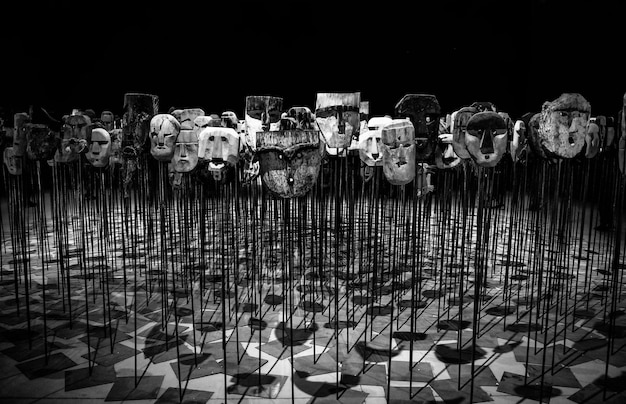Unveiling the Depths of in Drama Reviews

plays a crucial role in shaping narrative tension, character development, and thematic resonance within drama, offering viewers a profound exploration of human experiences.
Drama continually evolves, presenting narratives that reflect and challenge our understanding of the world. One element that consistently shapes and enriches these stories is .
The Essence of in Dramatic Storytelling
is a cornerstone of dramatic storytelling. It adds layers of complexity, influences character arcs, and drives the narrative forward. A deep understanding of is essential for appreciating the multifaceted nature of drama.
can manifest in countless forms, from subtle nuances to grand gestures, and its impact varies depending on its context and execution. Skilled writers and directors use to evoke emotions, provoke thought, and leave a lasting impression on the audience.
Defining and Identifying
What exactly is ? At its core, is the manifestation of underlying themes and conflicts within the narrative. It’s the link between the plot and the deeper messages the drama aims to convey.
- Symbolism: The use of objects, people, or ideas to represent something else.
- Motifs: Recurring elements that reinforce a particular theme or idea.
- Allegory: A story with a hidden meaning, often moral or political.
- Irony: The expression of one’s meaning by using language that normally signifies the opposite, typically for humorous or emphatic effect.
In essence, creates a richer, more immersive experience for the viewer. By recognizing and interpreting these elements, an audience gains a deeper appreciation for the drama’s artistic value and thematic depth.
Exploring the Historical Evolution of
The use of has evolved significantly throughout history. From ancient Greek tragedies to modern television dramas, has adapted to cultural shifts and technological advancements.
Examining how has been employed in different eras provides valuable insights into changing societal values and artistic conventions.

Ancient Roots
In ancient Greek drama, often served as a means of exploring timeless moral dilemmas. Plays like Sophocles’ “Oedipus Rex” used symbolism and allegory to comment on fate, free will, and the human condition.
The chorus played a vital role in interpreting for the audience, providing commentary and insights into the deeper meanings of the events unfolding on stage.
Over time, has moved away from direct commentary and has become more integrated into the narrative. Modern dramas often rely on subtle cues and visual metaphors to convey meaning.
How Enhances Character Development
is instrumental in character development, providing insights into a character’s motivations, flaws, and evolution. By examining how characters interact with and react to symbolic elements, viewers gain a comprehensive understanding of their inner worlds.
Characters who embody specific themes or engage in symbolic actions become more relatable and memorable, enhancing the drama’s overall impact. Their journeys are intertwined with , which reinforces the narrative.
Symbolic Actions
A character’s actions can speak volumes about their underlying beliefs and motivations. Seemingly simple tasks or decisions can carry significant symbolic weight, revealing hidden aspects of their personality.
Directors often use visual cues, such as clothing, props, and setting, to communicate a character’s state of mind or their place within the narrative’s broader themes.
- Clothing: A character’s attire can signify their social status, moral standing, or personal transformation.
- Props: Objects that hold sentimental or thematic significance.
- Setting: The location where a scene takes place can reflect the emotional landscape of the characters and the narrative.
Ultimately, character development is enriched by . It serves as a tool to deepen our connection with those characters, making us more invested in their stories.
The Role of in Creating Dramatic Tension
Dramatic tension is heightened through the strategic use of . Ambiguity, foreshadowing, and ironic situations keep the audience engaged and eager to discover the outcome.
Effective use of suspense is achieved by slowly revealing aspects of , maintaining a sense of anticipation and uncertainty. The tension is only resolved when is fully revealed.

Foreshadowing and Suspense
Foreshadowing involves hinting at future events or outcomes, creating a sense of unease or anticipation. This technique encourages viewers to pay closer attention to the unfolding events, searching for clues that will explain the foreshadowed outcome.
Suspense is built by delaying the resolution of a conflict or the revelation of a secret, keeping the audience on the edge of their seats. The strategic use of can amplify this suspense, making the payoff all the more rewarding.
The skillful use of ambiguity and irony creates layers of uncertainty, prompting viewers to question assumptions and consider multiple interpretations. Such ambiguity keeps the audience intellectually engaged, enhancing the overall dramatic experience.
Analyzing in Popular Drama Series
Studying how is employed in popular drama series offers valuable insights into effective storytelling techniques. By examining specific examples, viewers can develop a better understanding of how a director may use convey larger ideas.
Consider the use of color in “Breaking Bad,” or the recurring imagery of water in “The Sopranos.” These visual motifs enhance the narrative’s emotional impact and thematic depth.
Case Studies: Notable Examples
Let’s delve into specific instances of used in popular series to illustrate their effects:
- “Breaking Bad”: Color to show a character’s transformation or the moral decay within the show.
- “The Sopranos”: Recurring images of water to symbolize the characters’ emotional turmoil and the complexities of their relationships.
- “Mad Men”: The changing fashion styles to show change during different periods in history.
These examples demonstrate how skillful use of these devices can elevate a drama from being merely entertaining to being thought-provoking and artistically significant.
Interpreting and Appreciating Complex
To fully appreciate complex , viewers must actively engage with the narrative, paying attention to both explicit and implicit cues. Critical thinking and an open mind are essential for uncovering the subtle layers of meaning embedded within the drama.
Recognizing the historical and cultural context in which a drama is created can provide valuable insights into the creator’s artistic choices and thematic concerns. A better understanding of the background helps in interpreting .
Through a lens of thoughtful analysis, one can uncover the artistic and thematic depth. By doing so, drama becomes not just a form of entertainment, but a powerful medium for exploring the depths of human experience.
The Future of in Drama
technology continues to evolve, the use of in drama will likely become even more sophisticated and integrated. As digital media expands, new possibilities for visual and auditory .
The emergence of virtual reality (VR) and augmented reality (AR) technologies offers exciting new avenues for immersive storytelling. It allows viewers to step inside the drama, experiencing directly and enhancing their emotional connection.
The future of storytelling has the real possibility of completely changing. In the drama of tomorrow, audiences will not simply watch , and will be a part of it.
| Key Element | Brief Description |
|---|---|
| 🎭 Symbolism | Objects, people, or ideas representing something else. |
| 🔗 Character Arcs | Character development through interaction with . |
| ⏳ Dramatic Tension | Heightened by ambiguity and suspenseful . |
| 🎬 Visual and Auditory Cues | Use of clothing, props, and setting to show character. |
What are the main types of used in drama?
▼
Common types include symbolism (objects representing something else), motifs (recurring elements emphasizing themes), allegory (hidden moral/political meanings), and irony (expressing meaning via opposite language).
▼
enhance story depth by connecting plot to themes, shaping character arcs, evoking emotions, and prompting thought, leaving lasting audience impressions with complex messages.
▼
In the past, would be stated more directly, where recently its been incorporated much more into the narrative. Subtle cues and imagery have taken over.
▼
Understanding enriches viewing experiences, allowing viewers to see narratives in greater detail.
▼
As virtual and augmented reality expands, viewers will soon be able to step inside of their favorite dramas, living in the story instead of merely watching from the outside.
Conclusion
In conclusion, is a profound and multifaceted aspect of dramatic expression that significantly enriches the art of storytelling. From its historical roots to its contemporary manifestations, continues to play a crucial role in conveying complex themes, shaping character dynamics, and heightening dramatic tension. By engaging with complex , viewers can unlock a deeper appreciation for the narrative and expand their understanding.





